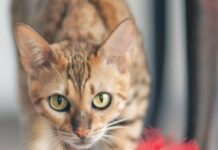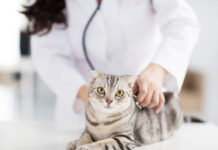Question: Ive always heard that one dog year equals seven human years, so a ten-year-old dog is like a 70 year-old person. Is this true for cats, too?
Answer: Not quite. For the record, a ten-year-old cat is, well, ten years old. But people often like to try to translate their cats years to human years. Ive heard the old one dog year equals seven human years equation all my life, too, but it really isnt correct for cats – nor for dogs, for that matter. Think about it for a moment: A one-year-old cat is physically mature enough to reproduce (assuming its not been spayed or neutered), and has been capable of doing so for a number of months. But how many seven-year-old kids do you know who could do the same? (Lets hope your answer is no – thank goodness!)
Early feline development is much more accelerated than early human development. Puberty and adulthood are all attained well within the first year and a half to two years of a cats life, so a one-year-old cat is more like a 15-year-old person, and a two-year-old cat is like a 24-year-old person.
Thereafter, each year in a cats life is worth about four human years, physiologically speaking. Doing a little math, you can see that a six-year-old cat is, from a physiologic standpoint, more-or-less equivalent to a 40 year-old person, a 10-year-old cat to a 56 year-old person, and a 16-year-old cat to an 80-year-old person.
———-
Question: Is it okay to give milk to my adult cat? My cat seems to really enjoy a few licks from the bottom of my cereal bowl each morning.
Answer: Im sure many of our readers are lactose intolerant, so they know what drinking a glass of milk does to them! Most cats develop essentially the same condition as they age (its normal) because they lose the enzyme, lactase, necessary to help them digest lactose, a sugar present in milk. As undigested lactose passes through the intestinal tract, it draws water along with it. In addition, bacteria present in the colon ferment the undigested sugars and produce volatile fatty acids. The excessive water and the bacterial breakdown products result in diarrhea.
Most cats can probably tolerate a little milk, but larger quantities will almost assuredly cause diarrhea. Cats eating a balanced and nutritionally complete diet dont require any of the nutrients in milk, so theres no reason to feed it.
———-
Question: My five-year-old cat grinds her teeth. She doesnt seem to be stressed out and seems perfectly healthy. Why does she do that?
Answer: Unlike some people, cats are not known to respond to stressful situations by gnashing or grinding their teeth – for better or worse, theyre much more likely to urinate on a wall. Oral discomfort is more likely. The most visible potential cause of pain would be inflammation of the gums or other parts of the oral cavity. Such areas would appear red or swollen, and easy to spot during a thorough oral exam.
Oral cancer must also be on the list, but is usually found in older cats.
A less apparent – but more likely – cause is a type of tooth lesion common in cats: a feline odontoclastic resorptive lesion (also known as FORL, neck lesion, or cervical line lesion). FORLs are cavity-like pits that form most often near the gum line. Approximately one third of all cats will develop FORLs sometime during their lives, with the likelihood increasing with age. Research has thus far failed to illuminate a cause, though many theories have been proposed.
Unfortunately, FORLs can be quite painful, depending on how far theyve progressed. Tooth grinding is a way that some cats manifest their discomfort; others choose to chew only on one side of their mouths (invariably the side opposite the tooth with the problem). Still others may suddenly open their mouths or chatter their teeth while chewing, and a few show no signs other than a diminished appetite. Extraction of the affected tooth is the current treatment of choice, and it completely relieves the pain.
Anytime a cat exhibits signs of oral pain, a visit to a veterinarian is in order. Evidence of an odontoclastic lesion can usually be found during careful oral examination-theyre usually concealed beneath reddened, gum-like tissue that appears to be growing over the tooth-but sometimes high-quality dental x-rays are necessary to disclose their presence. (X-rays would also help demonstrate a similarly painful, but less common, tooth root abscess.) A variety of sophisticated dental treatments have been used in an attempt to treat FORLs, but so far, none have been able to halt progression of the disease. Extraction of the affected tooth/teeth is the current treatment of choice, and it is highly successful in relieving the pain. Your cat will thank you.



